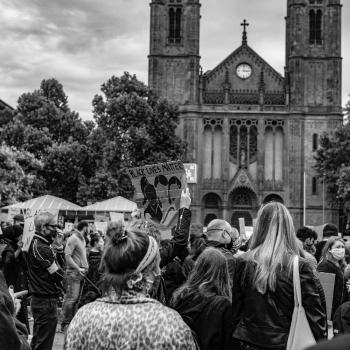Annually, my family and I go on a road trip that we call a “Kindness Quest,” where we make our vacation kind. Even though kindness and justice aren’t typically perceived as being in the same wheelhouse, spending day-after-day practicing intentional acts of kindness has made me consider the overlap between these two values. Is it possible that kindness and justice are the same thing?

The Kindness Quest
On the Kindness Quest I teach my kids about loving others and how practicing kindness creates a more flourishing world. Everyday we do an intentional or random act of kindness to bring home this point. We hope our actions bless others, but ultimately the Kindness Quests are training grounds to raise changemakers.
I’ve noticed that many Christians are resistant to practicing justice, but get excited by intentional kindness and applaud our Kindness Quests. The other day, as one of my teenagers was talking about these road trips, she stated that I use them to teach them about justice. If she saw the overlap between kindness and justice, surely we can, too.
Kindness and Justice Foster Flourishing
Sometimes our acts of kindness have been well received. The unhoused gratefully took the sandwiches we passed out, the protesters enjoyed their ice cold Gatorade, and the people at the drive-thru behind us whose meal we just paid for were thrilled. Definitions of kindness vary, but they center around consideration of others, generosity, friendliness, acting in concern of, and overall blessing others without expectation.
Kindness and justice both have the goal of blessing. Justice cares about the flourishing of all people equally, and kindness presents as kind acts that allow for others to flourish and feel valued.
Doing the Work of Justice Kindness Isn’t Well Received
In other instances, the Kindness Quest hasn’t gone so well. We’ve had unhoused individuals rudely demand $20 instead of food. We’ve had people release the balloons we gave them, annoyed to be burdened by a small pointless ball of helium. Many have been too anxious to take a small gift from us, assuming we wanted something in return. It is evident that people don’t always want to accept gestures of kindness.
I don’t think this push back is entirely unfair, though. People don’t receive kindness for a variety of reasons: fear, pride, and entitlement might be at the top of the list. But there are other reasons, too. Often, our “kindness” is too random; we aren’t meeting people with an actual need or desire they have. We begin asking questions to pivot our efforts. We even begin asking what factors leave people unhoused, why someone else is disgusted by balloons, and why the orphanage might not want the toys.
In addition, sometimes these moments show us that our random acts of kindness have become about us and our happy moment of giving. Or that we’ve lost the vision of blessing someone whether they deserve it or not.
When we begin diving into how to effectively bless others with kindness, we start moving into the work of justice, where we practice methods that are ideal, good, and right. I agree that we are learning about doing justice on our Kindness Quests, not because we are advocating for laws to change, protesting, or posting with hashtags #justicefor____. However, learning how to show kindness through a restorative lens of truly valuing humankind is also the work of justice.

Why Christians Practice Kindness
Kindness is similar to justice in that it presents by recognizing others’ value. As followers of Jesus, we believe all of humankind is created as God’s reflection, imago dei (Genesis 1:27). When humans are given dignity, both justice and kindness prevail.
As we talk about in this column, God calls Christians to practice justice. But kindness is also something that demonstrates God’s presence in us, as it is a “fruit of the Spirit” (Galatians 5:22-23). God himself is often described with the characteristics of both kindness and justice (Titus 3:4 and Psalm 11:7). We are told frequently to emulate God (Ephesians 5:1).
Even if kindness and justice aren’t exactly the same, they definitely originate from and are motivated by the same thing. They also can have a similar positive effect on others and our world.
We Are Also Receivers
At times we’ve had to become the unwanted recipients of kindness on our Kindness Quests. For example, one time my van died in a small mountain town. Over the span of 24-hours, half a dozen men I didn’t know helped me figure out what was wrong with my car and fix it, even though all the local auto mechanic shops were closed. The little motel manager let us hangout in the air conditioning, giving my kids juice and popsicles until hours after check-out time
This was humbling for me. We were supposed to be the givers! But we were forced to become receivers. We were the ones in need and these citizens were in a position to help.
The quickest way to eradicate saviorism is to receive from those we want to bless. This forces us back to the reality that we are all equal. We all have the same level of dignity–not because of what station of life we have, or what we’ve done to earn it. We are all on the same playing field simply because we each are designed to reflect God as his unique creation. Flipping the script by becoming receivers is vital both in practicing kindness and justice work.
How Kindness and Justice Are Different
Even though kindness and justice have significant similarities, justice meets people on foundational levels that aren’t visible to all, whereas by their very nature, acts of kindness are visible. Like my van on our Kindness Quest, justice is often only appreciated after its functionality is absent and then restored. Justice happens when things are working the way the right way, the way they should.
In addition, as justice encompasses systems, or as I call it, macro-love, justice isn’t typically individualized like kindness is. However, justice can look like kindness when someone with power or privilege implements an overarching standard of justice towards a person when it isn’t expected.
Justice Shouldn’t Always Be Attributed to Kindness
For example, when a White person stands in solidarity with a person excluded for the color of their skin, it is an act of restoring justice. Depending on the situation, it could be perceived as an act of kindness, too, especially if the individual who was excluded has a personal need to feel loved in this way at that specific time.
But, as all people are equal and no one should be excluded for the color of their skin at all, calling it “kindness” could also insinuate that the excluded individual didn’t deserve inclusion in the first place. As kindness usually presents as something unexpected, undeserved, or not a given, calling justice kindness can potentially create an atmosphere of do goodisms, charity, and saviorism that makes one person feel less-than and beholding. It really depends on the situation and how the one receiving feels valued and seen.
This goes back to what we were talking about earlier, how we must value others’ God-given dignity and level the playing field of humankind by humbly receiving. Even if justice isn’t often perceived as kindness, kindness must be led by the principles of practicing justice.
The Wheelhouse of Kindness and Justice
Maybe it is a little nit-picky to attempt to compare and contrast kindness and justice. However, I hope that by discussing these nuances, you can appreciate how these characteristics go hand-in-hand, even if kindness and justice aren’t exactly the same. If nothing else, I hope you’re inspired to engage in both, for the good and flourishing of others! Let’s all become more intentional with our acts of kindness and learn about and practice restorative justice through them.
Maybe you too are ready to make your vacation kind, by going on your own Kindness Quest with your family and friends or pick up my book, Justice-Minded Kids, which shares some of these stories!

















